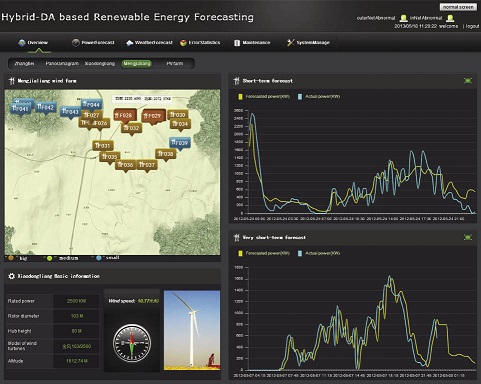
The screen from IBM’s HyRef shows the location of several turbines on a wind farm (upper left) in China. Graphs plot forecasted (yellow) and actual (blue) winds over several hours. Agreement looks quite good.
Big Blue says its advanced power and weather modeling technology will help utilities around the world improve the reliability of their renewable energy resources. “The solution combines weather prediction and analytics to accurately forecast the availability of wind power and solar energy,” says Michael Valicchi, IBM’s Global Energy and Utility Industry Leader. He says the effort will let utilities combine more renewable energy into the power grid, helping to reduce carbon emissions.
Valicchi says HyRef can predict the performance of each wind turbine and estimate the amount of generated renewable energy by using local weather forecasts. “This level of insight will let utilities better manage the variable nature of wind and solar, and more accurately forecast the amount of power that can be redirected into the power grid or stored. It will also let energy organizations combine other conventional sources such as coal and natural gas,” he adds. “We have developed an intelligent system that combines weather and power forecasting to increase system availability and optimize power grid performance.”
China’s State Grid Jibei Electricity Power Company Limited is using HyRef to integrate renewable energy into its grid. This initiative is phase one of the Zhangbei 670 MW demonstration project, the world’s largest renewable energy initiative that combines wind and solar power, energy storage, and transmission. This project contributes to China’s five-year plan to reduce its reliance on fossil fuels.
Phase one of the Zhangbei project aims to increase the integration of renewable power generation by 10% by using such wind forecasts. The efficient use of generated energy lets the utility reduce wind and solar curtailment while analytics provides the needed intelligence to enhance grid operations.
This project builds on another IBM smart-analytics initiative at Denmark’s Vestas Wind Systems. Valicchi says together with IBM’s big-data analytics and supercomputing technology, Vestas will position wind turbines on wind farms based on petabytes of data from weather reporters, tidal phases, sensors, satellite images, deforestation maps, and weather modeling research. Valicchi says this insight can deliver improvements in energy generation and reduce maintenance and operational costs over the life of the project.
HyRef is said to represent advancements in weather modeling that stems from other innovations such as Deep Thunder. Developed by IBM, Deep Thunder provides high-resolution, micro-forecasts for weather in a region –ranging from a metropolitan area up to an entire state–with calculations as fine as every square kilometer. When coupled with business data, says Valicchi it can help businesses and governments tailor services, change routes and deploy equipment-to minimize the effects of major weather events by reducing costs and improving service. WPE
Filed Under: News, Policy





